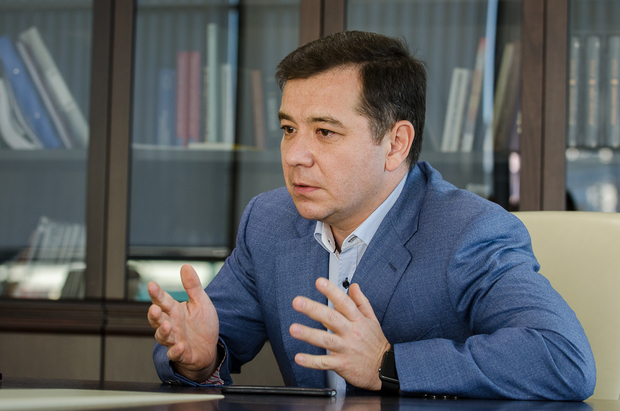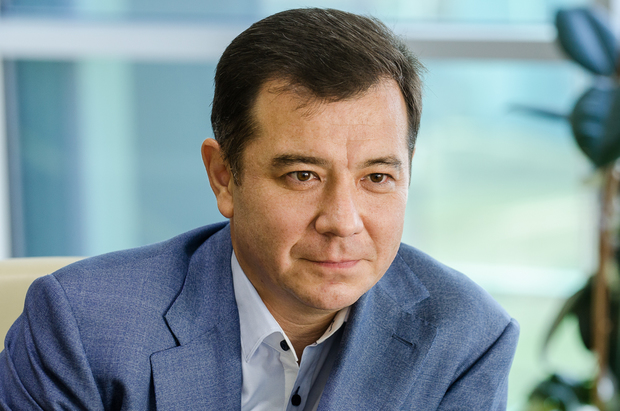Ruslan Gizzatullin: 'It is important to understand the task of the union of generating and grid companies'
The idea of uniting generating, grid and trade companies in a single energy company, which is promoted by Generating Company, caused a mass of mixed opinions. Although few people believe in the real merger of energy companies at the moment, independent generators joined the discussion. In an interview with Realnoe Vremya, the chairman of the board of directors of TGC-16 PJSC, which is a part of TAIF GC, Ruslan Gizzatullin stated there is no breakthrough without changing the energy development philosophy.
Mr Gizzatullin, Generating Company has claimed many times the necessity to consolidate generating, grid and trade companies in a single holding Tatenergo. This step is supposed to be the only means to recreate the self-sufficient energy system of the Republic of Tatarstan.
To start with, I have neither heard nor seen that Generating Company PJSC officially wrote and sent offers to anybody. This is why we can consider this question only as a hypothesis. Moreover, the issue on the division of types of activity and ban on merger of certain types of activity is clearly explained in the Federal Law-35 'On Power Engineering', which is the basic document that defines the work of the sector.
Speaking about the change of approaches, including the approach you have mentioned in the question, first of all, it is necessary to make amendments to the federal law. The second moment I would like to note is that any reformation has a sense if there are a clear task and goal, which was thoroughly considered and is to be achieved during the reform, as well as a detailed plan of its achievement. Then it is necessary to study the economic feasibility of this union and its consequences for people and the business. Just to say 'Let's unite' is not enough. The result without a clear vector, which was negotiated with all participants of the union, will look like in Krylov's fabula: 'And you, my friends, no matter your positions, will never be musicians!'
Indeed, changes are actively discussed in the sector now. It is supposed to make these changes in the law 'On Power Engineering' in the part about the merger of activities. I will say frankly, from my point of view, a part of them are reasonable. For example, offers on the allowance to combine activities of grid and trade companies who guarantee suppliers.

If there are certain goals, which are to be reached by these means, costs and consequences for the end consumer and the economy of Tatarstan after the end of the reformation, including a clear and transcendent programme of actions, we are ready to discuss the idea.
As for the grid union, generating and commercial assets, the effect and consequences of this union are not obvious. I fail to understand how the union of Grid Company and Generating Company can increase the competitiveness of a certain heat plant in energy wholesale market and its capacity. Its 80% is defined by the amount of fuel factor, that is to say, an efficient use of fuel for energy and heat generation. Electricity grid has nothing to do here.
This is why if there are certain goals, which are to be achieved by these means, costs and consequences for the end consumer and the economy of Tatarstan after the end of the reformation, including a clear and transcendent programme of actions, we are ready to discuss the idea. But we are afraid that the stated initiatives can be just a creation of underground financing mechanism of the united energy company with absolutely unclear processes of formation and distribution of costs. As usual, a consumer pays for everything…
Why 'electric' line sparks and 'Chubais' cross' is just a metaphor, and nothing else
Mr Gizzatullin, according to the results for 2015, the volume of energy generation in Tatarstan demonstrated a significant deceleration from the demand of the Tatarstan industrial indicators. In general, they 'imported' from the energy wholesale market 6bn kWh (or 29%) more than the Tatarstan energy system generated, so to speak. The administration of Generating Company PJSC considers it as a threat to the reliability of energy supply and even says about an appearance of 'Chubais' cross' in the Republic of Tatarstan when a deficit of its own generating capacities while energy consumption in the republic is growing stops the economic development of the republic.
Don't lump everything together. There is a problem of energy supply reliability, including energy-intensive consumers and consumers who refer to the first category of energy supply reliability. There is a problem of reduction of energy generation by heat plants of generating companies of the Republic of Tatarstan. Curiously enough, these problems have no direct link. Let's start one by one. Indeed, reliable energy supply for consumers and especially for industrial consumers is very important. At the moment, according to the existing norms in the sphere of industrial and energy safety, there are several energy supply reliability categories. The strictest requirements are imposed on the first reliability category. Energy supply for such consumers can't stop even for a fraction of a second because it can pose a threat to people's lives and cause a malfunction of complicated technological processes up to accidents and catastrophes.
It is clear production complexes of explosive and flammable productions like petrochemistry and oil refinery refer to this group of consumers. This is why energy supply reliability is of paramount importance for them. According to the existing norms and rules, at least two independent energy sources must supply energy for such responsible consumers. A sudden turn-off of one of them must not affect the activity of the other one and the quality of produced energy.
It should be said the republic has achieved a great breakthrough in this field in recent years. The administration of the republic adopted and approved a programme for the Nizhnekamskneftekhim energy region. It includes a detailed complex of measures that will enable to solve the problem of energy supply reliability for big energy consuming enterprises of the first reliability category located in the Nizhnekamsk industrial hub. This programme includes measures that Generating Company, such big industrial consumers as Nizhnekamskneftekhim, TAIF-NK PJSC, Taneco PJSC, generating companies like Generating Company PJSC, TGC-16 PJSC, Nizhnekamsk CHP PJSC are responsible for.

Reliable energy supply for consumers and especially for industrial consumers is very important
The programme is carried out by all participants within a time frame. A great job is done during its execution. New substations are built, the existing substations of Generating Company, switchgears and substations of industrial consumers are reconstructed; generating companies install new capacities and modernise the active ones; current limiting reactors are set in high-voltage lines; emergency prevention measures of protection devices are updated. As a result, the number of emergency shutdowns of industrial productions and damage of these breaks because of an interruption of external energy supply have reduced manyfold.
At the moment the same job is done in the Kazan energy region. All technical solutions have been found, terms and responsible people have also been appointed. The main idea is to form an energy ring of high-voltage lines and 220 kW substations near Kazan. Kinderi, Central and the Kazan CHP-3 substations will be its key stations. This scheme will enable to immediately send capacity to any point of Kazan via the 220 kW lines if necessary. Then the capacity will be distributed via lower voltage lines.
Now works are coming to an end in two substations – the Kazan CHP-3 and Kinderi. New generating capacities will be put into operation in CHP-3 the first quarter of 2017. Generating Company PJSC has almost finished the reconstruction of Kinderi substation. It is almost a new substation. A huge job has been done. Only cable relaying in several parts of the 220 kW lines in Kazan and construction of a line from Schelokov substation to Central substation left. Then energy supply reliability of the Kazan energy region can be crossed out from the agenda. In fact, it will be a foundation that can be used to provide a reliable energy supply scheme for any enterprise of any reliability category in Kazan.
Moreover, we made progress while providing reliable energy supply. At Generating Company's suggestion, it was decided to elaborate liaison protocols of Generating Company, big consumers (Tatneft and TAIF groups), generating companies, system operator in order to plan the repair work of the network, the main generating equipment and work hours, turnaround maintenance of petrochemical and oil refining enterprises. It will allow to maintain energy supply reliability for responsible consumers during repair works and a new construction of the grid infrastructure. There is a normal cooperation and dialogue here. Specialists hear each other and work together.
Anyway, Mr Gizzatullin, you are speaking about consumers. But how will they work if Tatarstan doesn't have enough its own generating capacities?
So we have approached the second part of the question. A clarification is needed. Firstly, the installed capacity of energy plants of the Republic of Tatarstan easily meets its consumers' current and prospective demand. For this reason, we can't speak about 'Chubais' cross', in other words, a situation when Tatarstan doesn't have enough generating capacities in order to provide reliability of the grid. This postulate is nothing more than a metaphor, it is far from reality.

The installed capacity of energy plants of the Republic of Tatarstan easily meets its consumers' current and prospective demand. For this reason, we can't speak about 'Chubais's cross', in other words, a situation when Tatarstan doesn't have enough generating capacities in order to provide reliability of the grid
Secondly, the reduction in energy production in the energy system of the Republic of Tatarstan is mainly connected with a decrease in production in the Zainsk State Regional Energy Plant from 9 to 6bn kWh and a number of energy plants of Generating Company PJSC. As for the Zainsk Energy Plant, the plant works almost all year round with minimum equipment in order to minimise losses of its owner caused by the work of the plant in the wholesale energy market.
Wait, there is a contradiction here. On the one hand, there are capacities. On the other hand, generation is falling because the existing plants are not competitive. Does it mean energy supply reliability is also reducing? But you are giving an opposite opinion.
There are no contradictions. The thing is that there are two sides of the same coin. There is a question of energy supply reliability in the balance of production and consumption of energy in certain conditions of the state of the grid, and there is a question of competitiveness of generating capacities in the energy market. Here reliability and stability of generating capacities of consumers are a priority.
Tatarstan is in a single energy system and connected with the external network by 500 and 220 kW main power lines that can carry all the necessary volume of energy to the republic in case of a deficit. In this respect, territorial borders of the regional energy systems are strictly relative. In power engineering, a system operator is responsible for reliability and stability of a single energy network. It is, in fact, a network manager who supervises the maintenance of a balance of production and consumption of energy in the single electricity grid of the Russian Federation at any moment and in any part, including in our republic, 24/7. When consumption falls, it sends a command to stop extra generating capacities. When consumption rises, there is a command to turn on the capacities that were kept in reserve. Naturally, he plans the work hours of plants taking into account the grid capacity and the presence of any reserve of generating capacities in order to serve greatest loads.
So, taking into consideration a good state of the network system of the Republic of Tatarstan and the developed topology of the grids, owners of ineffective generating capacities have an opportunity to minimise their work hours. So they are at a loss while using ineffective equipment. In brief, at the moment the decrease in energy generation by ineffective generating capacities of several companies doesn't reduce energy supply reliability and stability of a single energy system. Otherwise, the system operator would give a command to include these capacities in work regardless of the financial result they could get in the energy market.
Do you want to say that there is a sufficient reserve of generating capacities in the Republic of Tatarstan?
Both in the Republic of Tatarstan and the Russian Federation. What is more, even taking into consideration the necessity to have reserve capacities in case of a sudden growth of consumption or emergency shutdown of working generators in a single energy system of the Russian Federation, a great surplus of generating capacities has formed in recent years. It reached about 10 GW, which will grow with the appearance of new capacities. It is like 10 Zainsk Energy Plants.
At the same time it should be noted due to the existing rules of the wholesale energy market, if a power plant's equipment is out of use but is kept in reserve, the owner of this equipment gets a compensation for maintaining it in a working state in the form of the so-called payment for capacity. The paradox is that a power plant is able to not to produce even 1 kW, but its owner can guarantee himself or herself a rich existence due to this payment. And by means of a consumer! This is why nowadays in Russia removal of unnecessary and ineffective generating capacities in order to reduce the load on a consumer has been topical. A consumer has to pay for expensive generating capacities, which were to substitute old generators. In the end, we pay for the maintenance of both of them. Only TAIF Group of Companies annually pays over 1bn rubles to maintain energy plants that were put into operation on Power Supply Agreement and ineffective plants that were not removed.

The paradox is that a power plant is able to not to produce even 1 kW, but its owner can guarantee himself or herself a rich existence due to this payment. And by means of a consumer!
Speaking about the ratio of the price for which we sell energy and capacity in the market and our enterprises buy in the wholesale market, it differs two times! In other words, petrochemical and oil refining enterprises of TAIF Group of Companies annually overpay over 3bn rubles from the price for energy generated by TGC-16 PJSC. Consequently, it directly affects the competitiveness of their end product. If the current tendency doesn't change, this overpayment will have been over 8,5bn rubles per year, and payment on the Power Supply Agreement and ineffective generation will have made up 3,3bn rubles per year by 2020!
Why heat energy comes expensive for Kazan citizens
Mr. Gizatullin, does TGC-16 have questions on the provision of competitiveness on the electricity market?
Some questions we have. If we compare the results of work in 2014 and 2015, it is easy to see that at Nizhnekamsk CHP (PTK-1) the power generation volume has not changed, then at the Kazan CHP-3 the generation has decreased by 20%. This is mainly due to the decrease in heat distribution for heating and hot water of the consumers of Kazan in 2015 in comparison with 2014 by 11%. In fact, we have a process of combined heat and power production, and with decreasing quantity of heat production we are forced to reduce electricity production. Otherwise, its cost will exceed the prevailing prices on the electricity market. Here's an interesting story turns out: in Kazan, there are three CHP plants, two of them, Kazan CHP-1 and CHP-2 are in the ownership of Generating Company JSC, KCHP-3 — in the ownership of TGC-16 JSC.
Besides, the ownership of JSC Generating Company has three powerful district boiler-houses — the boilers Azino, Gorky, Savinovo. All these heat sources are connected by a network of trunk lines. So, these boilers release to the network about 2.5 million Gcal of heat annually, which accounts for almost 40% of the total heat output in the centralized heat supply system of Kazan!
It is no secret that the heat, produced in the mode of combined production in CHP, is always cheaper than the heat supplied from a boiler. The more heat a CHP releases, the more economical it is. Think about it, it is from this huge amount of heat that now is released from the boilers it would be possible to produce no less than one and a half billion kilowatt-hours of electricity in a deficit Kazan energy district! There is no need to build new generating capacities, we just need to load the existing ones.
To be clear, the figures are: a cost of energy (fuel component) of a modern combined cycle cogeneration plant without a release of heat is about 94 kopeks/kWh. If CCGT is with heat supply, its electricity will cost about 70 kopeks/kWh. The cost of electricity produced on existing equipment of CHP without heat release will be 1.5 rubles/kWh, but if you load it with thermal energy release, the cost of electricity will be 78 kopeks/kWh. As the saying goes, no comment.
Normally loaded generating equipment of CHP has an efficiency of fuel consumption and cost of electricity at the level of modern CCGT energy units. Now there are many talks about the need for urgent replacement of the existing equipment of CHP, as it is not competitive in the electricity market, they require from the government to develop a variety of payback mechanisms of a new construction of power plants.
In my opinion, the modernization and renewal of capacities are necessary but first we need to bring order in our household and to transfer heat release from boilers to CHP. Each Gcal of heat should be obtained by the combined production of heat and power. This will ensure their competitiveness.
But instead of increasing the consumption from CHP, including from Kazan CHP-3, Generating Company JSC loads the boilers. At the same time, the tariff from Kazan CHP-3 two times cheaper than the tariff set for the district boilers. Our experts counted that if to transfer all of the heat supply in Kazan from the district boilers to CHP, then the heat tariff for the population can be reduced by 15%.

In total, taking into account the growth of production of the group of companies TAIF and third-party consumers, the heat release at the power plants of TGC-16 rose from 17.1 million Gcal in 2011 up to 20 million Gcal in 2015
By the way, TAIF Group went this way since the acquisition of the Kazan CHP-3 and Nizhnekamsk CHP (PTK-1). In 2010, the boiler houses of the group of companies released 1.3 million Gcal of heat. In 2013, all boilers were terminated, and the whole heat load was transferred to CHP. Of course, this required the laying of new heat lines but the game was worth the candle.
In total, taking into account the growth of production of the group of companies TAIF and third-party consumers, the heat release at the power plants of TGC-16 rose from 17.1 million Gcal in 2011 up to 20 million Gcal in 2015. This gives the possibility, for example, at Nizhnekamsk CHP (PTK-1) to provide the indicators of fuel efficiency in accordance with modern CCGT units. Naturally, it affects the tariffs for supplied heat. Currently, they are almost two times lower the rates of other power companies of the Republic of Tatarstan and still remain lower the rates at which the industrial enterprises of Nizhnekamsk district purchased the heat before 2010.
Of course, due to the peculiarities of technological processes of production at the enterprises of consumers, the structure and volumes of consumption of heat at the Kazan CHP-3 and Nizhnekamsk CHP (PTK-1) are not the same. In Kazan, we have a stable heat consumption by industrial consumers but not enough to fully load all available reserves of the station. In 2015, the station released for the needs of the population of the city of Kazan 1.5 million Gcal of heat, it can further release another 1.2 million Gcal per year, according to the most competitive rates in the Republic.
How does TAIF see further development of its generating assets? What is in the nearest plans of modernization of the stations?
At the Kazan CHP-3, we are actually reaching the completion of complex modernization of the station. At the end of 2014, jointly with Kazanorgsintez OJSC we held reconstruction of outdoor switchgear at 110 kV with the construction of the 5th and 6th sections of tire. This allowed, in fact, to provide Kazanorgsintez with two independent power supply sources. We significantly reduced the number of shutdowns of the equipment of a consumer. We have reconstructed the turbo generator No. 1 and the heat scheme of the station with the installation of turbo feed plant. We are now completing the construction phase of a gas turbine topping of the station by installing a gas turbine units with a capacity of 389 MW of General Electric company production. All work is carried out according to the schedule.
The first example of this turbine was launched this year in France, by the EDF company. During the tests, the turbine showed a capacity of over 400 MW. We hope for a similar result. The actual installed capacity of the station will increase almost twofold and electricity generation for the same heat load is expected to grow three times.
We have big plans for the construction of generating capacities and at the Nizhnekamsk industrial hub. About that we will tell later. For now, I will only announce the figure: by 2020, according to our plans, the total capacity of power stations of TAIF Group of companies will increase 1.6 times. The heat energy release will increase 2.2 times and will be no less that 14.5 billion/kWh a year. This will give the possibility to meet all current and prospective needs in energy of the enterprises of pertochemistry and oil production and to supply electricity to the neighbouring regions of the Russian Federation.